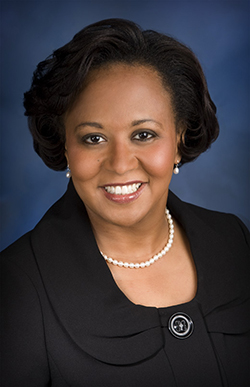Keynote
Genevra Walters: How Tech Can Close the Achievement Gap
Students who struggle need more technology, not less.
As superintendent of Illinois’ Kankakee School District, Genevra Walters has transformed a lackluster general ed program into the successful College and Career Academy Classrooms. With the help of technology in these classrooms, Walters has helped close the achievement gap for those students who were not enrolled in gifted or magnet programs.

Genevra Walters
In her short tenure at KSD, she has also helped the district go 1-to-1 in second through ninth grades, with kindergarteners and first graders getting easy access to iPads. She said she hopes to attain 1-to-1 access for Kankakee high schoolers within the next few years.
Prior to joining KSD in 2014 (located in her hometown), Walters served as a school social worker, assistant principal, principal and superintendent of SPEED, a special education school district based in Chicago Heights.
Walters hails from Kankakee, IL, about an hour south of Chicago. She graduated from Kankakee High School in 1986 and attended the University of Illinois at Chicago for both bachelor’s and master’s degrees in social work. She obtained her educational doctorate at Illinois State University in 2000.
THE Journal: What role did technology play in special education and the College and Career Academy Classrooms?
Genevra Walters: Students in special education and students with disabilities have an IEP (individualized educational plan). We were even broader in our implementation of technology than you might expect. We used traditional devices, but we also used assisted tech — technology to communicate, mobile, technology to modify instruction.
Students who struggle are often more dependent on technology to learn. More affluent kids are used to lots of technology because they could afford it. We could not afford not to have technology. For the disadvantaged students, their access to technology needs to increase in order to close the opportunity gap.
THE Journal: Parents who see their children playing on electronic devices day and night may have some skepticism about the advantages of technology. What do you tell them?
Walters: I’ve been trying to communicate to the community at large, the local community, many of whom believe that our students are becoming too dependent on technology. But technology changes so fast now. We need to understand that we’re actually training children for jobs that don’t even exist now. Because of that, if we don’t teach them to make sure technology is part of their everyday lives, they may not be able to access the jobs that are available in 10 to 20 years. Parents, teachers and students need understand it is actually part of a life of a child, not a separate thing that happens to students.
But we also need to monitor the use of technology. There are some students (with whom) we need to make sure that you have a balance. It’s important to have a balance in life to become a good, healthy, well-rounded adult.
THE Journal: What is your view of the Department of Education’s proposal (under the Obama Administration) that federal funds must supplement, and may not supplant, state and local funds? How does that affect the implementation of technology at the local level?
Walters: We look at schools that have a high poverty rate, and we look at our priorities — Title I funds are for technology first. Then based on what’s left, we look at what kind of support we need in the classroom for students to grow. We don’t use the money for anything that does not demonstrate student growth.
Local funds are for instructional materials. In terms of technology — that’s where we’re able to use federal funds, which actually helped us get Chromebooks for second through ninth grade and iPads for kindergarten through first grade.
THE Journal: Do you see technology having an impact on the way young people learn?
Walters: Youth culture is different compared to adults. It’s different because technology is changing the way their brains operate. There’s research that indicates that children are having a different attention span, or level of attention, than adults. Technology does change the way the brain is forming, or the ability to attend to a project. We still need to teach our students to attend to things with concentration, to build resilience.
THE Journal: What about books and reading?
Walters: I think a combination of both [analog and digital] is best. I still like to feel the page. I like reading online. But I still like to hold a book in my hand.
THE Journal: Do you have an opinion about BYOD, or bring your own device?
Walters: We’re struggling with deciding with what that should look like. I think having more devices is actually helping students learn.
THE Journal: What about policies regarding personal smartphones in class and possible cheating?
Walters: In junior high and high school, we have common areas where they can use their smartphones. Or if a teacher asks them to take them out during instruction, that’s allowed. It’s a device. They can use their iPhones or smartphones when appropriate — the issue is really behavior management.
We have to re-examine this whole concept of cheating anyway. They may be using [smartphones] in a group setting anyway. Is it sharing or is it cheating? We have to work that out.
About the Author
Richard Chang is associate editor of THE Journal. He can be reached at [email protected].